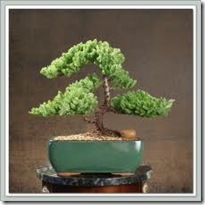 Slanting Form
Slanting Form
In this form the trunk itself slants as though growing toward the light or as though exposed to strong wind. The trunk can be straight or curved with branches on the sheltered side lower than their counterparts on the other side of the trunk. An important feature with this form is that the nebari or roots should appear to anchor the tree to stop it ‘falling’. The roots on the side to which the tree leans should be short and compressed whilst the roots on the opposite side should be strong and dominant, anchoring the tree into the ground.
Windswept Form
The windswept form is one of the most difficult forms to portray as a bonsai though is often one attempted by beginners for its dramatic features.
The windswept form is also one of the most misunderstood forms. The typical windswept bonsai is styled with all of its branches on one side of the trunk flung out towards one side by some invisible force! This cliche rather spoils the form but is often repeated.
The windswept form can be divided into two different types; the tree that grows under near continual winds (like those that grow on windswept coasts) and secondly, trees that are hit by a sudden gust of wind.
Permanently Windswept Bonsai
In nature, trees that are subject to strong winds on a regular basis will look windswept, even on a still day (see images below). It is obvious to the eye that the tree is shaped by the wind.
Growth is predominantly in one particular direction;the branches will tend to be longer on the sheltered side of the tree. Branches on the side of the tree that face the wind will be shorter.
The mistake that many enthusiasts make is to believe that a windswept tree cannot have branches or trunks facing into the wind. On occasions, trees can be found with branches on just one side particularly in very exposed coastal positions. My opinion is that these are often ugly specimens and their existence certainly does not mean that all windswept trees should be styled in this way.
What causes windswept trees to predominantly grow in one direction?
Very often Spring buds facing the wind are damaged by cold Spring winds. However, the buds on the sheltered are protected and are able to develop into branches as normal. This results in lop-sided growth over the tree, plenty of growth on the sheltered side, little or no growth on the exposed side of the tree.
A similar effect is caused by late Spring winds on tender spring growth; growth on the exposed side of the tree can be stunted or killed whilst growth on the sheltered side is protected.
The result of just 2 or 3 severe Spring gales on an annual basis can produce a very lopsided tree with growth predominantly toward the sheltered side of tree.
One criticism I often hear is that windswept bonsai cannot have trunks or predominant branches growing into the wind. Unfortunately, this is a sentiment of held by those that all branches should be flung out in one direction by centrifugal force!
Why do windswept trees in nature have trunks that grow into the wind?
I have no definitive answer for this but know that is does occur. I believe there maybe a combination of factors. Firstly, as discussed above, buds on the exposed side of the tree will be damaged, that is, the majority of buds will be damaged. Those that remain will have greater vigour as the energy received from the roots will spread between far fewer buds. When they extend in spring, these buds will produce will produce coarser, stronger growth that is more likely to be dominant and eventually become a heavy branch.
Secondly, the wind at ground level is nearly always slowed by surrounding vegetation and obstacles. Therefore the negative effect of the wind on a tree will be relatively weak closer to the ground. For this reason it is entirely conceivable to find a tree that grown towards the direction of the wind until it reaches a height where the wind does have a negative effect on new growth. At this height and above, growth will be predominantly in the same direction as the wind.
Temporarily Windswept Bonsai
In recent years it has become more common to see trees styled in such a way as to illustrate the effect of being caught in a temporary gust of wind, for instance during a gale.
These trees have growth toward and away from the wind as a normal tree would but the fine branches and twigs are placed in the same direction of the wind; the thinner and weaker the branch or twig, the greater the influence of the wind. Similarly, the stronger the gust of wind, the heavier the branches that can be seen to move with the wind.
Heavy branches and trunks, too thick and stiff to be moved by the wind, will remain in their fixed positions; including facing into the wind.

Deprecated: strpos(): Passing null to parameter #1 ($haystack) of type string is deprecated in /home/agriviek8Qv/agriviet.net/public_html/wp-includes/comment-template.php on line 2522